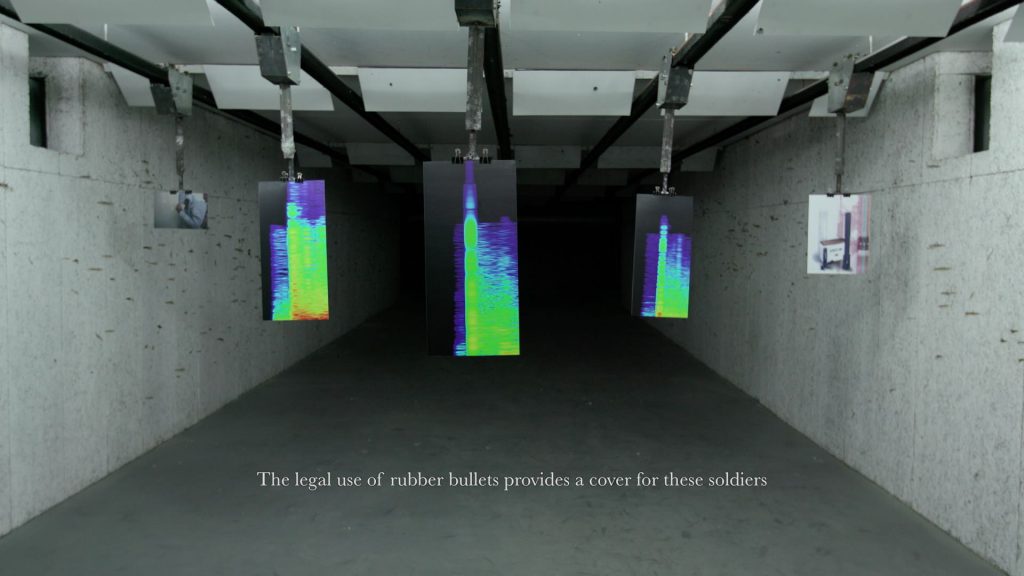Lawrence Abu Hamdan’s Many Silences: “Rubber Coated Steel” (2016)
14 August 2017By John Nyman

In Beirut—or, perhaps equally probable, in Toronto—a woman or a man shakes their head at me. Not the slow back-and-forth of a stubborn “No,” but a rapid jostle, with something like the velocity of a spring recoiling. It means “I don’t understand,” “I didn’t hear you.”
Growing up in settler Canadian culture, I learned to communicate the same message with a blank stare, maybe a head cocked sideways. But I find something different in the Arabic gesture, which isn’t so passive or absorptive. It is, in part, supplicant, since it admits there is something crucial the gesturer hasn’t grasped. But it is also assertive, even commanding: it says, “You meant to say something, so say it!” Rarely do I feel so called to account for being misheard.
The analogy is imperfect—which is, of course, partly the point—but the dynamic of the gesture permeates Lawrence Abu Hamdan’s Rubber Coated Steel, a 22-minute short film I first saw at the Beirut Art Centre in summer 2016, then a second time at Toronto’s Images Festival this past spring 2017. While Abu Hamdan’s film is usually described as an investigation of the legal implications of sound and silence, these themes tell only part of the story. More often, Rubber Coated Steel situates us in a broken telephone network, where the idea of silence as such is little more than an alibi for what we can’t or won’t listen to.
The point is made most powerfully, I think, at the end of the film, in the transcript of a court trial we neither see nor hear. In a heroic moment of defiance, the prosecutor calls on members of the court’s audience to speak up as witnesses. But all that follows in the text is a single, repeating description: “[Inaudible].” The judge brings in an official translator; “You may now speak in your own language,” he says. Still the transcript reads, “[Inaudible].” “Judge: Can’t they hear me?” “[Inaudible].”
The entirety of Abu Hamdan’s film recounts the trial of Ben Deri, an Israeli border police officer caught on camera shooting four unarmed Palestinian protesters—including Nadeem Nawara and Mohammad Abu Daher, who were killed—on Nakba Day (May 15), 2014. Our only access to the trial, however, comes in the form of its transcript, which is presented line by line as a series of subtitles. All we see throughout the film is the alley of a shooting range, whose targets have been replaced with photos, graphs, and spectrograms that advance and recede as they are cited in the transcript. All we hear is the range’s automated machinery, whose screeches and clanks echo through the soundproof bunker.
Certainly the deafness of the Israeli legal apparatus, for which the voices of the trial’s audience are forever lost, is one of Abu Hamdan’s targets in Rubber Coated Steel. Yet the film also calls into question far more nuanced instances of not-hearing, including its viewers’. At the centre of the trial is a forensic audio analysis—conducted, in real life, by Abu Hamdan himself—demonstrating that the shots Deri fired were not rubber bullets, as the Israeli military maintained, but live ammunition. When the sounds of each kind of gunfire are compared at trial, it is reportedly difficult to hear the difference; the judge even notes that he has a “tin ear” for this kind of listening. But the viewer of Abu Hamdan’s film is faced with an even more complex problem: we have not heard the sound of the gunshots at all. While we are allowed to see the silent yet convincing diagrams of each shot’s sonic profile, the sequence left me wondering: how legitimate is my faith in documentary evidence when I cannot lay claim to any tangible experience of the event at all? This disjunction is driven home by the forensic analyst’s claim that the only people who can truly hear the difference between the gunshots are the on-the-ground protesters at the back of the courtroom—whose statements, of course, we do not only not hear, but also cannot even read in the transcript.
Rubber Coated Steel offers no easy answers, only the painful realization that the law and the world are riddled with distinctions that are seen and heard by some but not by others. Among the most enraging moments of the film are those in which parts of the court transcript are presented struck out, having been officially removed from the record after the fact. The longest struck out section—presented over the course of several subtitle transitions—describes instructions posted on an Israeli military website for making lethal ammunition sound like non-lethal rubber bullets. For me, reading these lines induced two kinds of horror. The first regarded the callousness and racism of a military culture bent on dodging its responsibility for willful murder. But the second came with my realization, even before I finished reading, that what I was reading would be formally disregarded by those who most needed to see it. Recorded only under erasure, these lines—much like Deri’s rubber coated steel gunshots—are hidden in plain sight. We know far in advance what follows them in the transcript: “Objection.” “Sustained.” I don’t understand, I didn’t hear you.
Abu Hamdan shows us that to be silent and to be silenced are very different things—wisdom that applies as well in figurative terms as it does to the very literal world of firearm technology. To silence oneself may have yet another meaning. Although the results of Nawara’s autopsy were crucial in having Deri brought to trial at all, Abu Daher’s body was never exhumed—a fact that directly led to some important statements being stricken from the court record. Why wasn’t an autopsy of Abu Daher’s body ever performed? We are told that Abu Daher’s family believed it would be unnecessary, since, in their view, the cause of his death (by shooting) was so obvious. In the prosecution’s words, “The family has invoked their right to silence.”
There is strength in this silence, though it is not in the mystery or depth of silence so often fetishized by Western artists. It comes from silence’s solidarity with what has already been heard loud and clear, and which therefore does not require documentation in a courtroom that will ultimately only silence it again.
On one level, I can’t help but find this conclusion deeply unsatisfying, as my thirst to see justice prevail in the Israeli-Palestinian conflict demands the exposure of all its truths and wrongs. One of Rubber Coated Steel’s greatest accomplishments, however, is its demonstration that my faith in un-silencing stems from an inherently privileged position, one that ignores the extent to which even the conflict’s best-documented realities are consistently undermined and dismissed. I too am responsible for what I cannot see or hear—Deri’s gunshots, Abu Daher’s body, Palestine—and I am always caught up in moments of not understanding and not being understood. But if there is any justice worth fighting for, it will acknowledge the process and dialogue of this understanding as well as its many silences.
Rubber Coated Steel (2016) was screened as part of the ‘Hearing Eyes, Seeing Ears – International Shorts 1’ at Images Festival in Toronto, ON on April 22, 2017.
Feature image is a still from Rubber Coated Steel (2016) by Lawrence Abu Hamdan, courtesy of Images Festival.



